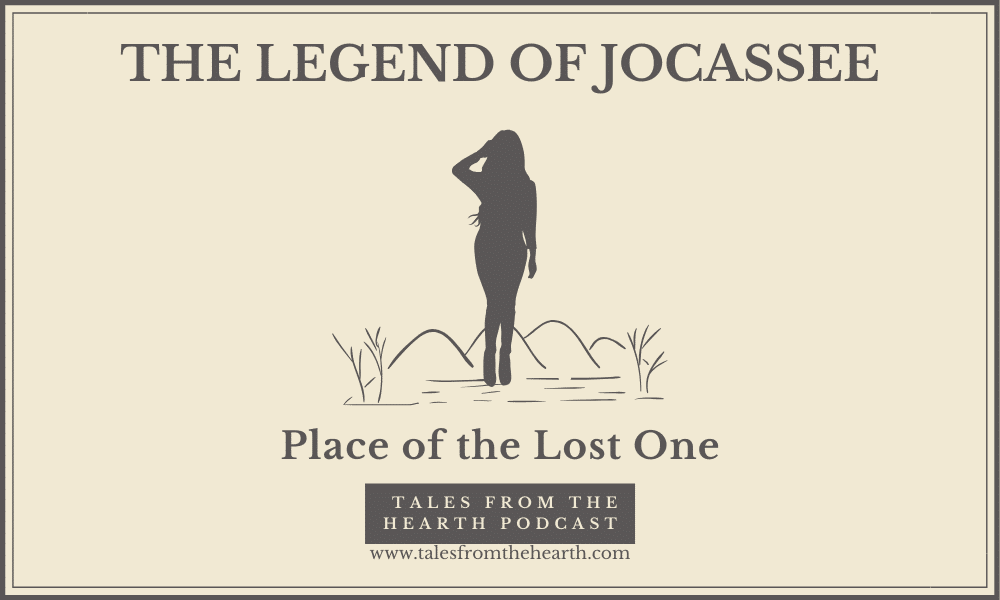The Legend of Jocassee
Have you ever heard of the legend about a woman who fell in love with her family’s greatest enemy? How about the legend of a woman who walked underneath the water to be reunited with her lost lover? Join us for today’s episode on the legend of Jocassee.
Let’s get cracklin’, shall we?
**********
Jocassee is a Cherokee word meaning, “Place of the Lost One,” and it could not have more meaning today than it did for the Cherokee people a long, long time ago.
Today, Lake Jocassee, located in northwestern South Carolina, is known as one of the most gorgeous and well-preserved man-made lakes in the southeastern United States. But almost 300 feet below its surface lies the remains of a lost town and civilization.
You can go on YouTube and view scuba diving videos that show the remains of a lodge, a girls’ camp, a steel truss bridge, a cemetery, entire forests of trees—among other lost (but not forgotten) things. In the 1972 movie Deliverance, you can view this cemetery and other Jocassee Valley landmarks before it was flooded shortly after the film’s release.
Long before this area was the lost home of many, it belonged to the Cherokee people. One could say it was many times lost due to the strife the area experienced throughout its history.
The Jocassee Valley was named after Jocassee, the star-crossed daughter of Chief Attakullakulla (or shortened to Atakulla), whose story we’ll talk about today.
Sources for today’s story are: Many! As always, refer to the episode show notes at www.talesfromthehearth.com for links to all of the resources for today’s episode.
A primary resource for this episode is a book entitled The Wigwam and the Cabin by William Gilmore Simms published in 1845. This is considered to be a highly romanticized and anglicized tale, but is known as the source of the local legend.
A great resource that gives historical facts behind the legend is Cherokee Myths and Legends: Thirty Tales Retold by Terry L. Norton.
Many facts, photos, and history of the Jocassee Valley and Lake Jocassee are from a book entitled Lake Jocassee (Images of America) by Debbie Fletcher.
You can view many photos and links to information about Jocassee, and other tidbits from today on our Pinterest board located at https://www.pinterest.com/TalesfromtheHearth/Jocassee
The One Takeaway I hope you get from this story is: You don’t always have to rise to a challenge, or meet anger with anger.
Now, I hope you enjoy the Legend of Jocassee.
**********
Lake Jocassee is located in northwestern South Carolina, close to the North Carolina border and within Devils Fork State Park. Covering nearly 7,500 acres and 300-400 feet deep in some places, it is the upper reservoir of the Keowee-Toxaway Project, supplying 710 megawatts of electrical power to the area. Lake Jocassee is part of the Jocassee Gorge, which is over 43,500 acres of conservation area. It is fed by five rivers—the Keowee, Toxaway, Thompson, Horsepasture, and Whitewater.
The number of motorized boats allowed in the lake is limited each day, so it’s usually a gorgeous and peaceful experience to take a day out on or tour the lake. You can view the otters, bald eagles, and catch fish of legendary sizes within its cool waters fed by mountain springs. The glassy waves are perfect for skiing, while the nearby state park allows access for swimmers and kayakers, who can camp along the many sites on its shoreline. If you visit, don’t forget to view its many waterfalls and beaches—most notably “Tahiti Beach” where the crystal clear waters shine due to flecks of mountain mica. National Geographic featured Lake Jocassee and the Jocassee Gorges as one of the “50 of the World’s Last Great Places—Destinations of a Lifetime.”
Below the idyllic surface of the man-made lake lies the “place of the lost one.” There were many things left behind when the valley was flooded to support a hydroelectric station. In the film Deliverance, you can view some of the Jocassee Valley, including the actual relocation of a church, Mount Carmel Baptist Church, and most of its cemetery before they were flooded shortly after the film’s release. Families were given the choice to relocate their loved ones or leave them in place, so there are still graves that remain underwater today. The Jocassee Dam is also featured in the movie, and is 385 feet high and 1,750 feet long. The stately Attakulla Lodge rests beside it, still intact under the cool depths of the lake.
Before the Jocassee Valley was lost to many Scotch-Irish families, it was lost to the Cherokee people, who lost a most treasured maiden to its waters.
Now time for the legend…
Many, many years ago, the Cherokee people lived on the Jocassee and Keowee Rivers that flowed in the place where the two lakes lie today between Pickens and Oconee counties in South Carolina. On the east bank of Keowee River (translating to “The Place of the Mulberry”) lived the Estatoee or Estatoe people, whose symbol was the green Estatoe “Carolina parakeet” (extinct since 1904), and on the west bank, in today’s Oconee County, lived its rival clan, the Oconees (translating to “watery eyes of the hills”), who were represented by the brown viper.
The rivalry was bitter and longstanding due to a battle between the two chiefs of the tribes many, many years before. Chief Chatuga of the Oconee brown vipers lost his bid to become a supreme chief to Chief Toxaway, whose name meant “place of thunder,” the fearsome warrior of the Estatoe green birds. You could say that Chief Chatuga was a sore loser, and resorted to name-calling and insulting the Estatoees at every opportunity. Tension ensued, and each tribe went out of their way to avoid each other, including their lands and the banks of the Keowee River.
Nagoochee was a young and much talked-about hunter and warrior of the Estatoees. One day he hunted long and hard, but came up short until he saw a buck deer later in the day. No matter how hard he tried, he couldn’t bring down the deer. The deer zigged when Nagoochee zagged. The deer came close to Nagoochee, only for Nagoochee’s arrow to hit far away. Nagoochee thought this was a test of his skill, or perhaps a trap from a rival Oconee sorcerer. Nevertheless, Nagoochee couldn’t give up his pursuit and ventured deep into the lands of the rival Oconee tribe. He continued to zig, zag, and finally found the deer eating just within his range. He jumped, but tripped over a small tree and rolled downward, breaking his leg. He found himself stuck and helpless on his rival’s land—fully expecting to suffer capture, torture, and death.
It was at that moment that he heard the most beautiful voice of a young woman sing out and echo through the valley. The voice came closer and closer until a young woman appeared and asked the injured brave who he was. Nagoochee was pretty sure that she was an Oconee, but nonetheless removed his shirt to reveal the tattoo of the green Estatoe parrot. Even so—she promised to come back and help the injured rival. He waited and waited, unsure that she would return. Evening fell into full dark night before she finally returned with other Oconee tribe members, who lifted him away, taking care not to further injure his broken leg. This was the first time he heard her name—Jocassee.
The injured Nagoochee was taken to Jocassee’s father, the Peace Chief Attakulla. He accepted Nagoochee even though he was of the rival Estatoe clan, and Jocassee took care to set Nagoochee’s leg and nurse him back to strength for several weeks.
Nagoochee and Jocassee spent much time together during Nagoochee’s recovery, and found that they had fallen in love and wanted to marry. Chief Attakulla approved of the union, and referred to Nagoochee as his son. The young couple had only one more approval to obtain—that of Jocassee’s brother, the fearsome warrior, Cheochee.
This bothered Jocassee because, unlike her father, Cheochee was very quick to anger and hated the Estatoe tribe. She feared that her brother would not approve, and they would be unable to marry. Fortunately for the couple, Cheochee was away for an extended time on a local hunt—but at the same time, they wanted him to return quickly to obtain the approval they needed to marry.
Nagochee returned to his tribe on the east banks of the Keowee River to prepare for the wedding, while Jocassee waited for her brother Cheochee to come back from his hunt.
While the couple remained separated, a great messenger appeared from their tribes’ Supreme Chief Moytoy. A great host of wolves was threatening the region, and he called for all warriors to gather together to hunt them. Most of the warriors were eager to demonstrate their skills and worth in front of all of the tribes, and traveled to the upper Whitewater River waterfalls to heed their Supreme Chief’s call. All, including women and children, were invited, so Chief Attakulla and Jocassee also traveled, the latter ecstatic to see and be reunited with her love, Nagochee.
The Oconee tribe turned out in full force with their large brown viper flag, demonstrating their power and pride and taunting all of the other tribes. At the center of all the insults was Cheochee, whose permission Jocassee needed to marry Nagoochee of the rival green bird clan. Nagoochee was nowhere in sight.
Very late into the gathering and celebration, suddenly the Estatoe tribe sang out and danced in celebration—their best warrior, Nagochee, had finally arrived!
Cheochee, Jocassee’s brother, immediately saw Nagochee as a personal rival. He also noticed how his sister talked about and looked at him. And he didn’t like it—no, not at all.
Cheochee’s heart hardened even more when he heard of his father’s approval of Nagoochee’s marriage to Jocassee. Attakulla even referred to Nagoochee as a second son.
This wouldn’t do. No—this wouldn’t do at all.
The day of the wolf hunt came, and the rival tribes of the Estatoe and Oconee found themselves united in fighting the fearsome wolves, displaying their bravery and skill. But of all the hunters, Nagoochee emerged as the bravest and most skillful of them all. At the end of the day, even though Nagoochee’s Estatoe Green Birds had the least number of hunters, they had the largest number of wolf skins to show for their efforts. Supreme Chief Moytoy declared them to be the winners of the hunt, so the Estatoees celebrated. Cheochee didn’t like that—no, not at all.
Chief Moytoy also recognized Nagoochee for being the best hunter. Nagoochee was told that he could have anything he asked for as his reward. Without hesitation, Nagochee asked if he could marry Jocassee.
The Oconees laughed and were angered by the request from a rival Estatoe. Cheochee angrily pulled Jocassee away from Nagoochee and challenged Nagoochee to a fight. Both Oconees and Estatoees erupted loudly in anger and fueled the fires of the challenge.
But Nagoochee refused to fight Jocassee’s brother, and Chief Moytoy also reminded the tribes to remain peaceful. The Estatoees couldn’t believe that Nagoochee wouldn’t rise to a challenge, however, and rumored that their prized warrior wasn’t that brave. Nagoochee felt shamed and resolved to yet again prove himself.
As all of the tribes departed from the hunt the next day, the rival warrior Estatoees and Oconees found themselves traveling a little too close for comfort. When two Estatoees were separated from the group, seven brown viper Oconees accosted the two and beat them up, ripping up their green bird banner and tying them to its post.
When Nagoochee and the Estatoees learned of this, they resolved for revenge, and lay in wait for the Oconees—even though the Oconees outnumbered them more than two to one. They attacked the Oconee warriors as they passed, and much blood was shed—with Nagoochee leading the charge.
Cheochee saw his opportunity to take down his rival and (would be) brother-in-law, Nagoochee, so he waited for precisely the right moment. Nagoochee fiercely felled another Oconee brave, who grabbed Nagoochee’s legs tightly in his death grip. Although his opponent was dying, Nagoochee was pinned with no way to easily extricate himself. Cheochee saw his moment, and stabbed Nagoochee in the heart.
Meanwhile, Jocassee had gone ahead to the Sarratay River and had sat anxiously waiting for her brother, Cheochee, and Nagoochee. It was very late when finally the Oconee braves arrived, singing of their heroic battle and win over the Estatoe warriors. Jocassee was worried about Nagoochee and didn’t know what to think. Cheochee arrived at last—but the first thing Jocassee noticed was that he proudly wore Nagoochee’s scalp around his neck.
Jocassee made no sound or cry, but took her place in a canoe to cross the river and return home. When she reached the middle of the river, she glanced back and stared longingly at the bank from which she had departed. She slid out of the boat and was lost to the river, never to rise again from its depths.
The Sarratay River was renamed the Jocassee River in her honor, meaning “place of the lost one.”
The Cherokee women say that she had seen her lover, Nagoochee, summoning her from the bank that day, and walked underneath the river to join him. The couple traveled together far, far away to a beautiful valley where they lived in peace as a hunter with his love.
Ah, such a sad tale! This is clearly a Romeo and Juliet tale, but it seems much more sad for some reason. I wonder whatever happened to Cheochee? I don’t like to wish bad things to happen to people, but I really hope he saw his error and reformed his ways. Nagoochee wasn’t completely without fault either—he probably should have continued his resolve not to fight the Oconees, even when they attacked the two Estatoe warriors. What did he think would happen when he attacked his lover’s tribe with the intention to kill? It was pretty impetuous to try to take on more than double your number in hand-to-hand combat.
Nagoochee could have shown his leadership by brokering peace with the two tribes. He could have leveraged his tribe’s thirst for revenge to convince Cheochee to let Jocassee marry him to keep the peace. Ah—I guess if that had happened, we would not have such a moving story to explain the naming of the Jocassee River and Valley.
So what are the facts behind this legend? The telling of this legend is problematic in many ways. Firstly, it is unlikely that there was a great wolf hunt that brought the two rival tribes together. According to most Native American beliefs, wolves would not have been hunted; instead, the tribes would have gone out of their way to avoid them because they were considered such special creatures. Only certain Native Americans would kill wolves, and then only if absolutely needed, because they would have had to ritually cleanse themselves and their weapons for killing a sacred animal.
The Supreme Chief in the legend, or Emperor Moytoy, who called for the gathering and wolf hunt, is documented to have existed, and lived circa 1687 until 1741. Chief Attakullakulla also existed and lived circa 1707 until 1777 and played a big part of local history during this time. It is documented that he had a niece, Nanyehi, who became Nancy Ward when she married an English trader.
There is, however, no record that Jocassee existed. William Gilmore Simms’ popular legend of Jocassee is considered to be just that—a work of fiction.
That’s it for today! I hope you enjoyed today’s story about the Legend of Jocassee.


